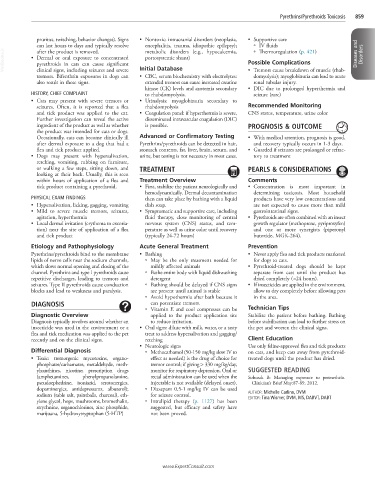Page 1706 - Cote clinical veterinary advisor dogs and cats 4th
P. 1706
Pyrethrins/Pyrethroids Toxicosis 859
pruritus, twitching, behavior changes). Signs • Nontoxic: intracranial disorders (neoplasia, • Supportive care
can last hours to days and typically resolve encephalitis, trauma, idiopathic epilepsy); ○ IV fluids
VetBooks.ir • Dermal or oral exposure to concentrated Initial Database Possible Complications Diseases and Disorders
metabolic disorders (e.g., hypocalcemia,
after the product is removed.
○ Thermoregulation (p. 421)
portosystemic shunt)
pyrethroids in cats can cause significant
clinical signs, including seizures and severe
tremors. Bifenthrin exposures in dogs can • CBC, serum biochemistry with electrolytes: • Tremors cause breakdown of muscle (rhab-
domyolysis); myoglobinuria can lead to acute
also result in these signs. extended tremors can cause increased creatine renal tubular injury.
kinase (CK) levels and azotemia secondary • DIC due to prolonged hyperthermia and
HISTORY, CHIEF COMPLAINT to rhabdomyolysis. seizure (rare)
• Cats may present with severe tremors or • Urinalysis: myoglobinuria secondary to
seizures. Often, it is reported that a flea rhabdomyolysis Recommended Monitoring
and tick product was applied to the cat. • Coagulation panel: if hyperthermia is severe, CNS status, temperature, urine color
Further investigation can reveal the active disseminated intravascular coagulation (DIC)
ingredient of the product as well as whether is possible. PROGNOSIS & OUTCOME
the product was intended for cats or dogs.
Occasionally, cats can become clinically ill Advanced or Confirmatory Testing • With medical attention, prognosis is good,
after dermal exposure to a dog that had a Pyrethrins/pyrethroids can be detected in hair, and recovery typically occurs in 1-3 days.
flea and tick product applied. stomach contents, fat, liver, brain, serum, and • Guarded if seizures are prolonged or refrac-
• Dogs may present with hypersalivation, urine, but testing is not necessary in most cases. tory to treatment
retching, vomiting, rubbing on furniture,
or walking a few steps, sitting down, and TREATMENT PEARLS & CONSIDERATIONS
looking at their back. Usually, this is seen
within hours of application of a flea and Treatment Overview Comments
tick product containing a pyrethroid. • First, stabilize the patient neurologically and • Concentration is most important in
hemodynamically. Dermal decontamination determining toxicosis. Most household
PHYSICAL EXAM FINDINGS then can take place by bathing with a liquid products have very low concentrations and
• Hypersalivation, licking, gagging, vomiting dish soap. are not expected to cause more than mild
• Mild to severe muscle tremors, seizures, • Symptomatic and supportive care, including gastrointestinal signs.
agitation, hyperthermia fluid therapy, close monitoring of central • Pyrethroids are often combined with an insect
• Local dermal irritation (erythema to excoria- nervous system (CNS) status, and tem- growth regulator (methoprene, pyriproxyfen)
tion) near the site of application of a flea perature as well as urine color until recovery and one or more synergists (piperonyl
and tick product (typically 24-72 hours) butoxide, MGK-264).
Etiology and Pathophysiology Acute General Treatment Prevention
Pyrethrins/pyrethroids bind to the membrane • Bathing • Never apply flea and tick products marketed
lipids of nerve cells near the sodium channels, ○ May be the only treatment needed for for dogs to cats.
which slows normal opening and closing of the mildly affected animals • Pyrethroid-treated dogs should be kept
channel. Pyrethrins and type I pyrethroids cause ○ Bathe entire body with liquid dishwashing separate from cats until the product has
repetitive discharges, leading to tremors and detergent dried completely (≈24 hours).
seizures. Type II pyrethroids cause conduction ○ Bathing should be delayed if CNS signs • If insecticides are applied in the environment,
blocks and lead to weakness and paralysis. are present until animal is stable allow to dry completely before allowing pets
○ Avoid hypothermia after bath because it in the area.
DIAGNOSIS can potentiate tremors.
○ Vitamin E and cool compresses can be Technician Tips
Diagnostic Overview applied to the product application site Stabilize the patient before bathing. Bathing
Diagnosis typically revolves around whether an to reduce irritation. before stabilization can lead to further stress on
insecticide was used in the environment or a • Oral signs: dilute with milk, water, or a tasty the pet and worsen the clinical signs.
flea and tick medication was applied to the pet treat to address hypersalivation and gagging/
recently and on the clinical signs. retching Client Education
• Neurologic signs Use only feline-approved flea and tick products
Differential Diagnosis ○ Methocarbamol (50-150 mg/kg slow IV to on cats, and keep cats away from pyrethroid-
• Toxic: tremorgenic mycotoxins, organo- effect as needed) is the drug of choice for treated dogs until the product has dried.
phosphates/carbamates, metaldehyde, meth- tremor control; if giving > 330 mg/kg/day,
ylxanthines, nicotine; prescription drugs monitor for respiratory depression. Oral or SUGGESTED READING
(amphetamines, phenylpropanolamine, rectal administration can be used when the Sobczak B: Managing exposure to permethrin.
pseudoephedrine, isoniazid, serotonergics, injectable is not available (delayed onset). Clinician’s Brief May:87-89, 2012.
dopaminergics, antidepressants, albuterol); ○ Diazepam 0.5-1 mg/kg IV can be used
sodium (table salt, paintballs, charcoal), eth- for seizure control. AUTHOR: Michelle Carlino, DVM
EDITOR: Tina Wismer, DVM, MS, DABVT, DABT
ylene glycol, hops, mushrooms, bromethalin, ○ Intralipid therapy (p. 1127) has been
strychnine, organochlorines, zinc phosphide, suggested, but efficacy and safety have
marijuana, 5-hydroxytryptophan (5-HTP) not been proved.
www.ExpertConsult.com

